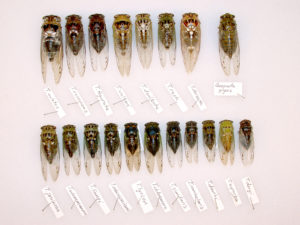Hadoa duryi Davis, 1917
Song type: Call
Source: ©Insect Singers | Species: H. duryi
Video Playlist
Playlists contain multiple videos found on YouTube.
Hadoa duryi song by Tim McNary
Name, Location and Description
- Cicada Name: Hadoa duryi Davis, 1917
- Short Name: H. duryi
- Synonym/Former Name: Tibicen duryi
- Where it is found: AZ, CO, NM, OK, TX, UT
- Maps: Biogeography of the Cicadas (Hemiptera: Cicadidae) of North America, North of Mexico [PDF]
- Description: Black and orange patterns. White and orange on the abdomen.
- Eye Color: orange
- Pronotal Collar Color: orange
- Identification: Bug Guide
- Identification: Bill Reynolds on iNaturalist
- Identification: iNaturalist
- Taxonomic Information: Integrated Taxonomic Information System
- Hadoa duryi Davis, 1917 images
- Song: http://www.insectsingers.com/100th_meridian_cicadas/western_species.html
W.T. Davis’ description1 from 1917:
Type male, Jemez Springs, New Mexico, 7,000 ft., June 27, 1917 (John Woodgate). Davis collection.
Allotype female. Box Canyon, Grant County, June, 1912 (Charles Dury). Davis collection.A black and reddish species much resembling an Okanagana in coloring, especially when the wings are closed. The head at the eyes not much broader than the front margin of the pronotum.
Head above black with the following marks deep orange in color: a spot on front, a somewhat triangularly shaped one just behind this, one above each antenna, and one irregular spot each side of the ocelli at the back of the head extending to back of the eyes. Pronotum black margined with orange, and slightly broader so on the posterior margin than on the anterior and sides. The tops of the raised portions occupying the central part of the pronotum are deep orange-colored and darker than the margins. Mesonotum black with a pruinose spot each side near the anterior margin (sometimes nearly obliterated), and a pruinose stripe each side near the base of the wings. The hind margin, the elevated portion of the X, two spots at the extremities of the X , and four spots (two inner curved) beyond the depression, orange. Tergum black with two pruinose spots at the base, one large one each side below the tympanum on the third segment, and also more or less conspicuously pruinose on the eighth segment. The posterior margins of all of the segments, except the first and second, narrowly lined with red, which is conspicuously broadened on the eighth segment of the female. The female from Fort Grant, Arizona, has a blacker dorsum, but the hind margin of the eighth segment is conspicuously red. Fore wing with the costal margin straw-colored to the end of the wing ; subcostal vein black ; first and second cross veins infuscated. The basal cell of each fore wing with about the outer half conspicuously blackened ; more clear at base. The wings are red at base, including the flaps of both the fore and hind pair. There are also some conspicuous black markings interspersed with the red at the base of the wings. Beneath orange, with what dark markings there are about the head nearly concealed by pruinose and silvery hairs. The transverse rugs are black; the legs are orange conspicuously streaked with black. The opercula orange, with the extremities rounded and the inner margins over-lapping. The last ventral segment orange, narrowed and somewhat rounded at the extremity. The valve also orange-colored. The external parts of the genitalia nearly all black.
Male Type | Female Allotype
Length of body: 28mm | 26mm
Width of head across eyes: 10mm |9.5mm
Expanse of fore wings: 73mm | 74mm
Greatest width of fore wing: 11.5mm | 11.5mm
Greatest width of operculum: 6mm |n/a
Greatest length of operculum: 6mm |n/a
Classification:
Family: Cicadidae
Subfamily: Cicadinae
Tribe: Cryptotympanini
Subtribe: Cryptotympanina
Genus: Hadoa
Species: Hadoa duryi Davis, 1917
List of sources
- Wm. T. Davis. SONORAN CICADAS COLLECTED BY HARRY H. KNIGHT, DR. JOSEPH BEQUAERT AND OTHERS, WITH DESCRIPTIONS OF NEW SPECIES. Journal New York Entomological Society. Vol. xxv. 1917
- Full Binomial Names: ITIS.gov
- Common names: BugGuide.net; The Songs of Insects by Lang Elliott and Wil Herschberger; personal memory.
- Locations: Biogeography of the Cicadas (Hemiptera: Cicadidae) of North America, North of Mexico by Allen F. Sanborn and Polly K. Phillips.
- Descriptions, Colors: personal observations from specimens or photos from many sources. Descriptions are not perfect, but may be helpful.
Notes:
- Some descriptions are based on aged specimens which have lost some or a lot of their color.
